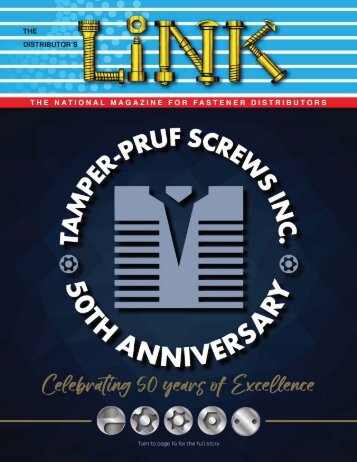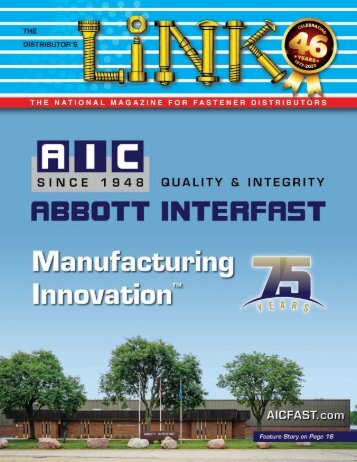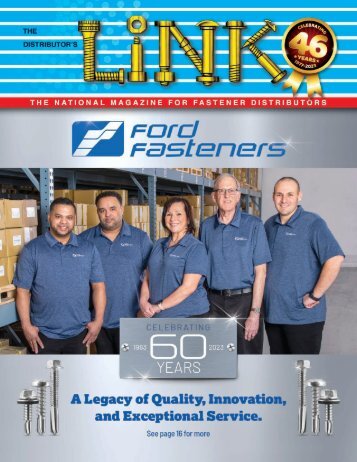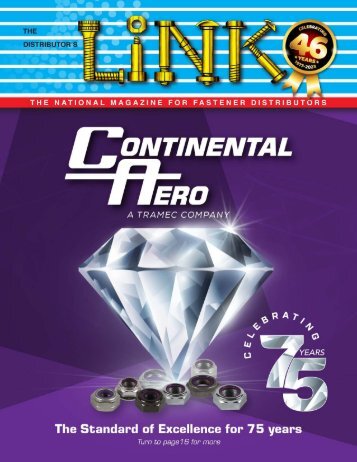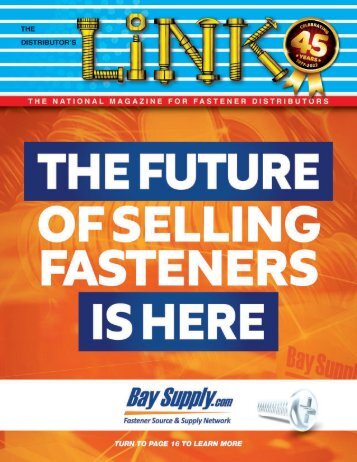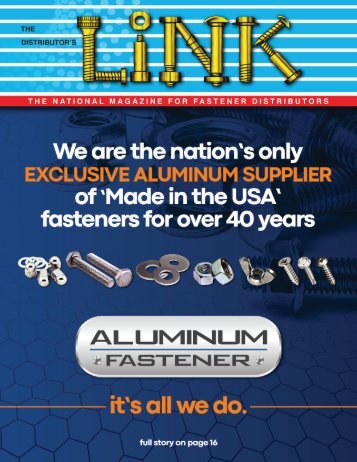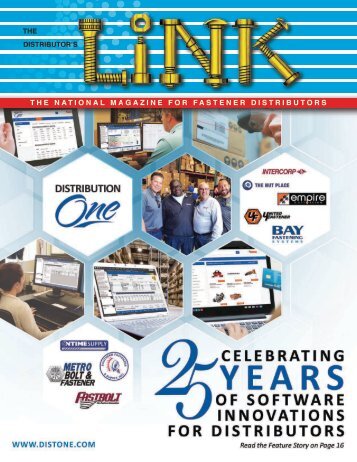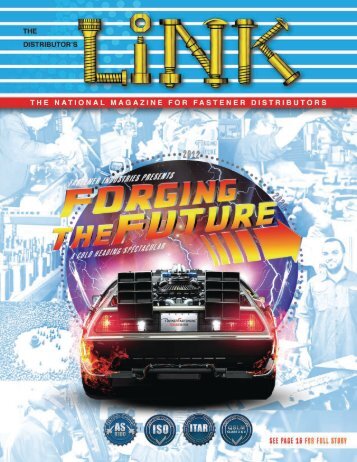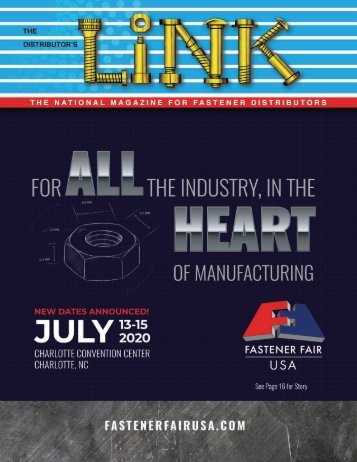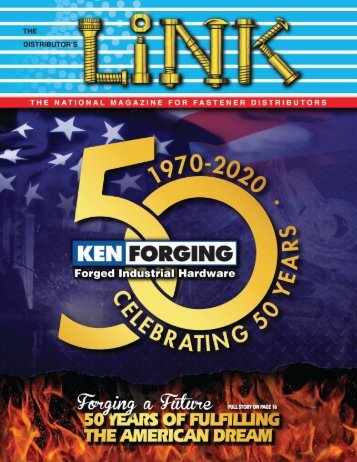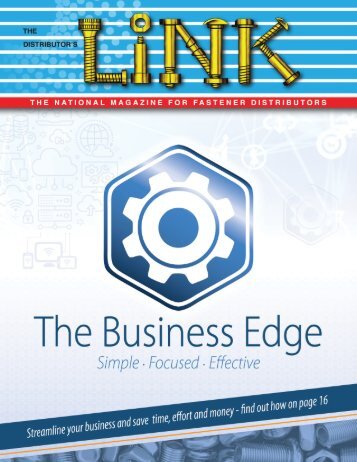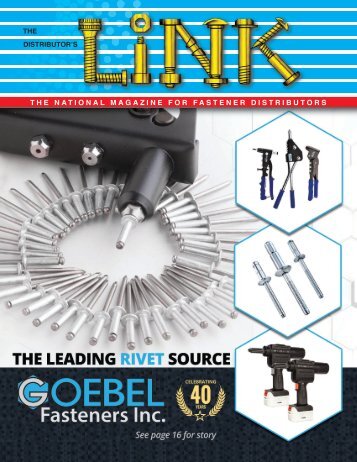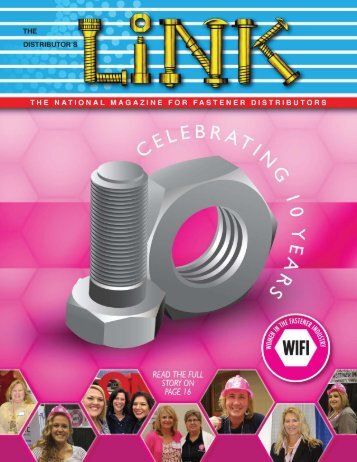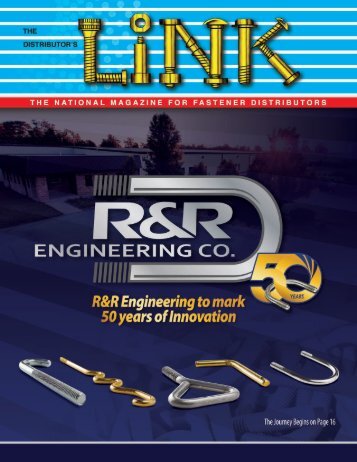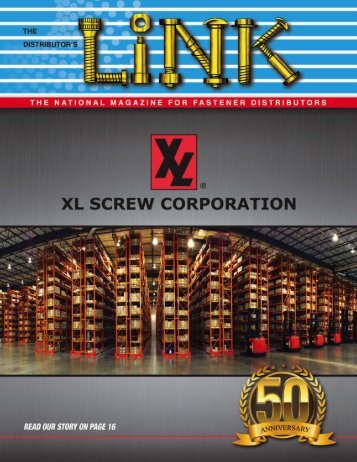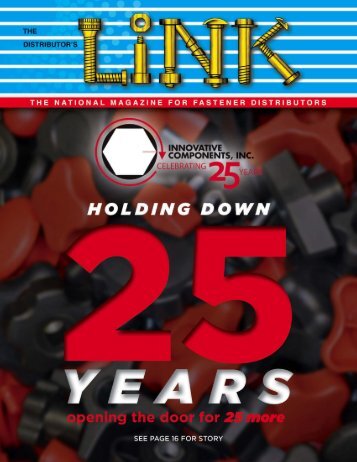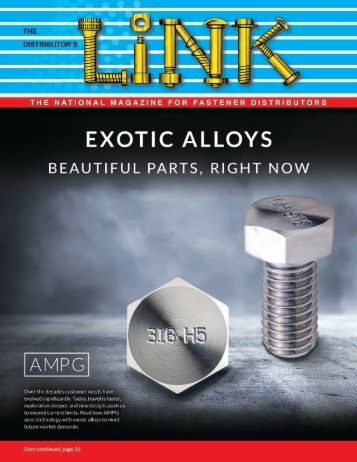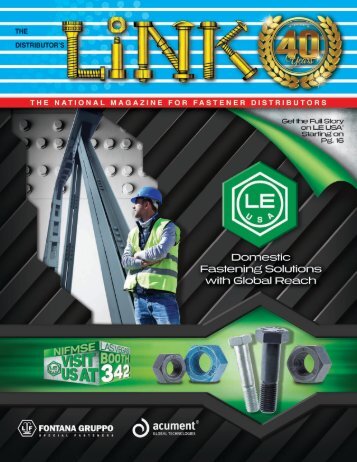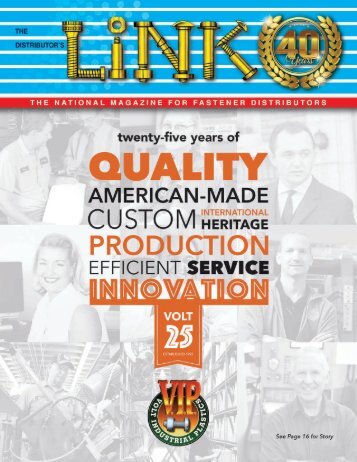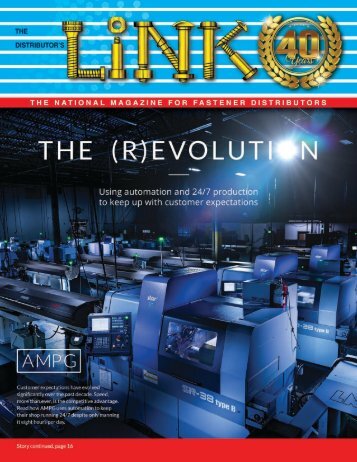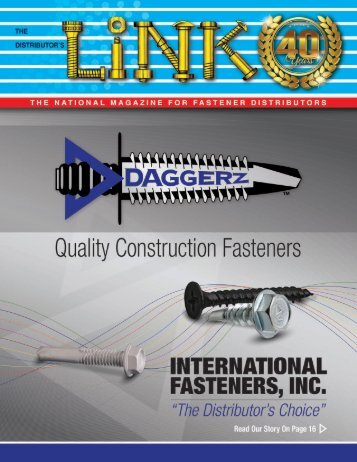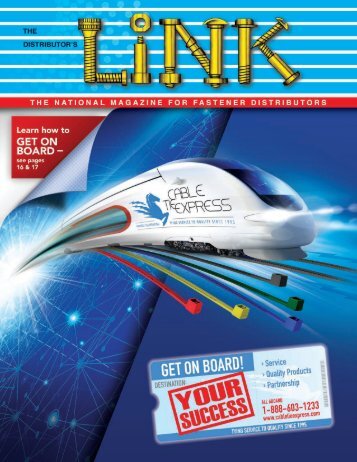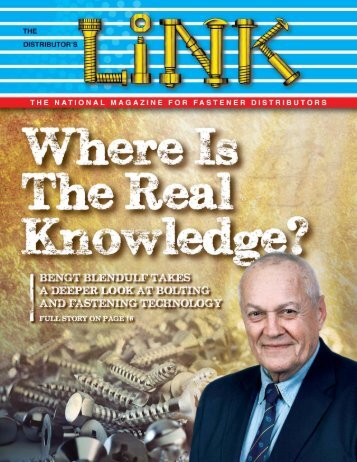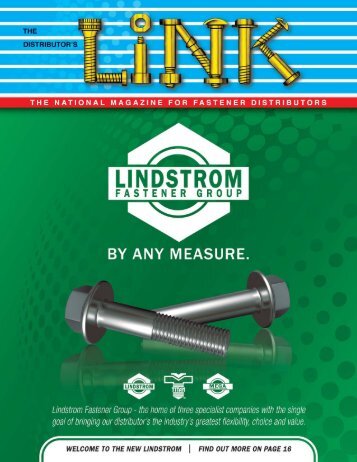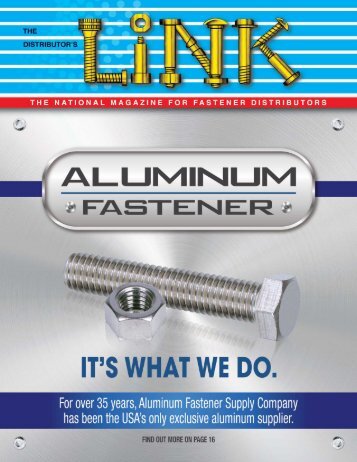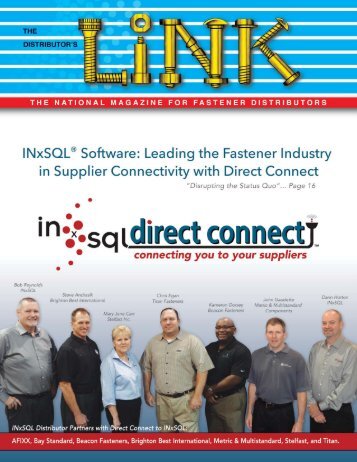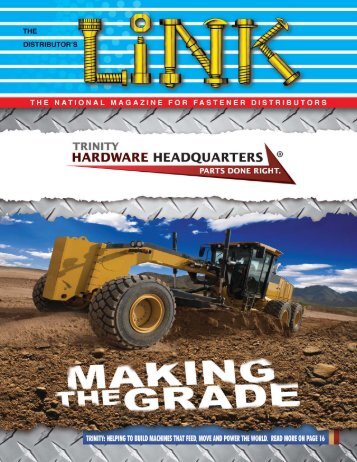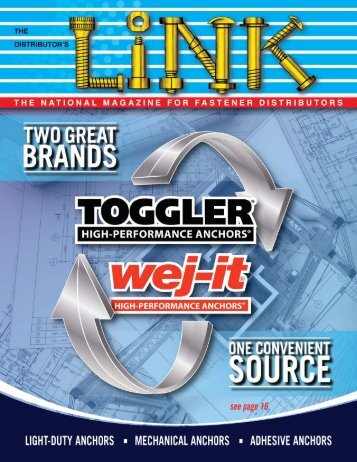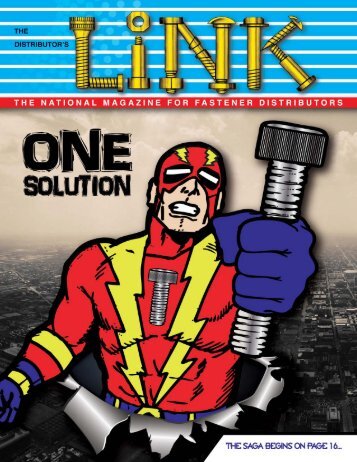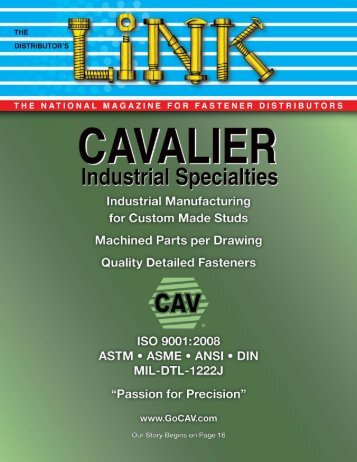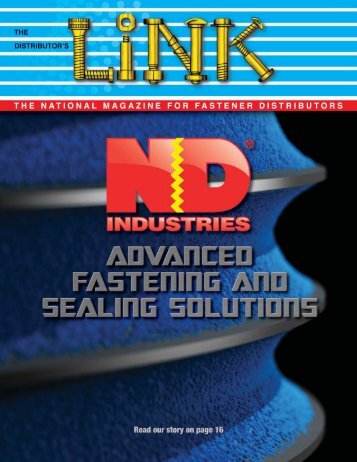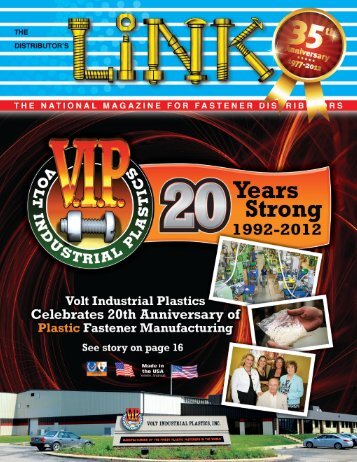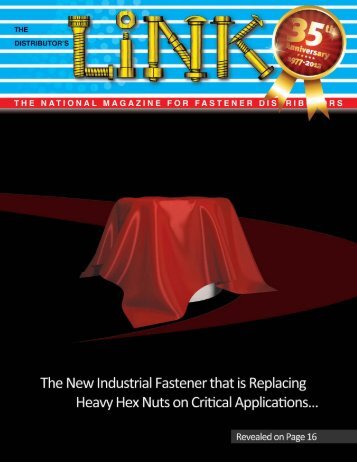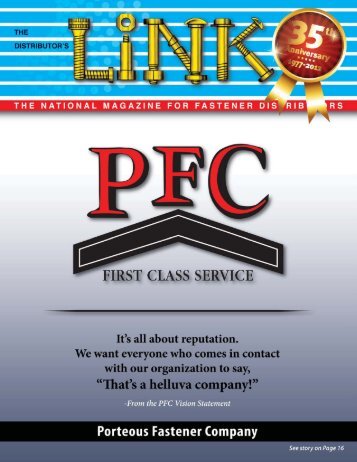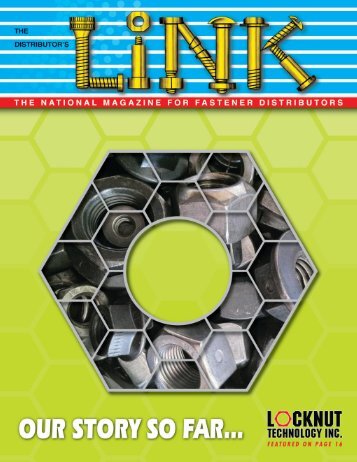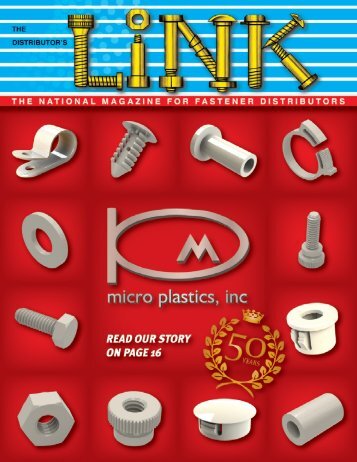SPRING 2023
- Text
- Wwwgraphikacreativecom
- Rivet
- Bolt
- Distributors
- Manufacturing
- Torque
- Association
- Products
- Screws
- Fasteners
- Fastener
30 THE DISTRIBUTOR’S
30 THE DISTRIBUTOR’S LINK ROTOR CLIP COMPANY INC. 187 Davidson Avenue, Somerset, NJ 08873 TEL 1-800-557-6867 EMAIL info@rotorclip.com WEB www.rotorclip.com WHAT MAKES RETAINING RINGS THE RIGHT SOLUTION? In today’s mechanical motion systems, the vast majority of power transmission is rotational, and, as a result, shafts are often present in everything from motors in UAV drones to 3-D printers. When shafts are assembled into final products, fasteners are placed at the ends or at fixed linear distances along the shaft where components need to be located. Traditional fasteners like screws, nuts, bolts, cotter pins, and washers require threading, tapping, drilling, and other machining operations. Retaining rings are metal fasteners installed into a groove on a shaft or in a bore creating a shoulder that resists thrust loading and keeps the assembly together. Rotor Clip is the only manufacturer of every style of Retaining Ring, ensuring end users receive the most optimal solution for their application. There are three main types of retaining rings: Constant Section Retaining Rings feature a uniform, constant section that provides three-point contact with the groove. Tapered Section Rings grip the entire periphery of the groove along the ring’s edge. Spiral Rings are wound from a single section of flat wire and provide 360-degree axial contact. Retaining rings are used in virtually every industry, supporting primarily automotive, medical, aerospace & defense, oil & gas, and energy sectors. Retaining rings’ light weight, simple, and fast assembly properties make them ideal candidates for product assembly simplification and cost reduction, providing several advantages over traditional fasteners. A single retaining ring can replace multiple pieces of hardware in an assembly. There is no need for complicated shaft or housing preparation such as threading, tapping, and drilling leading to lower fabrication time and costs. As a result, this is an economical fastening solution for manufacturers. Spiral retaining rings are an advanced solution for retaining ring applications that require 360-degree contact with the groove and shoulder of the part being assembled. They are designed not unlike a torsion spring and allow expansion (unwind) to slip over shafts and contraction (wind) to squeeze into bores. Spiral retaining rings require additional force to operate over taper and constant section rings, and, in return, offer a stronger fixing strength for the assembly. These rings are manufactured by coiling a single flat wire and can be single or multiturn; depending on the application requirements giving spiral retaining rings a broad range of standard and custom sizes up to 25 inches in diameter. Key advantages of this manufacturing technique are that there is no stamping waste or edge burrs and no concern about orientation of metal grain. Rolled flat wires have a natural radiused edge making them easier to slide into or onto position. Dedicated tooling is not necessary, making spiral retaining rings attractive for low-quantity custom applications. This manufacturing method avails itself to popular materials such as carbon and stainless steel as well as alloys such as Inconel, Hastelloy, and beryllium copper. TECHNICAL ARTICLE ROTOR CLIP COMPANY INC.
- Page 6 and 7: In the Spring 2023 issue of 6 DISTR
- Page 8: 6 THE DISTRIBUTOR’S LINK Goebel F
- Page 12: 10 THE DISTRIBUTOR’S LINK Bruno M
- Page 16: 14 THE DISTRIBUTOR’S LINK SEE YOU
- Page 19 and 20: which Continental-Aero has been abl
- Page 22: Did you know we offer a full line o
- Page 26: You can count on us to be your trus
- Page 34: 32 THE DISTRIBUTOR’S LINK THE FAS
- Page 37 and 38: Greenslade & Company is proud to an
- Page 42: 40 THE DISTRIBUTOR’S LINK COMPUTE
- Page 45 and 46: THE DISTRIBUTOR’S LINK 43 INTEGRA
- Page 48: 46 THE DISTRIBUTOR’S LINK FCH SOU
- Page 51 and 52: THE DISTRIBUTOR’S LINK 49
- Page 54 and 55: 52 THE DISTRIBUTOR’S LINK PENN EN
- Page 56: 54 THE DISTRIBUTOR’S LINK MID-WES
- Page 60 and 61: 58 THE DISTRIBUTOR’S LINK Robert
- Page 62 and 63: 60 THE DISTRIBUTOR’S LINK INDIANA
- Page 64: 62 THE DISTRIBUTOR’S LINK Joe Dys
- Page 68: 66 THE DISTRIBUTOR’S LINK SPECIAL
- Page 71 and 72: THE DISTRIBUTOR’S LINK 69 Auto Bo
- Page 73 and 74: THE DISTRIBUTOR’S LINK 71 UNICORP
- Page 76 and 77: 74 THE DISTRIBUTOR’S LINK Wrought
- Page 78 and 79: 76 THE DISTRIBUTOR’S LINK Roman B
- Page 80 and 81:
78 THE DISTRIBUTOR’S LINK NATIONA
- Page 82:
80 THE DISTRIBUTOR’S LINK SHEREX
- Page 85 and 86:
THE DISTRIBUTOR’S LINK 83 BTM MAN
- Page 88 and 89:
86 THE DISTRIBUTOR’S LINK AFC Ind
- Page 90:
88 THE DISTRIBUTOR’S LINK OBITUAR
- Page 94 and 95:
92 THE DISTRIBUTOR’S LINK GLOBALF
- Page 98 and 99:
96 THE DISTRIBUTOR’S LINK BAY SUP
- Page 100 and 101:
98 THE DISTRIBUTOR’S LINK WOMEN I
- Page 102 and 103:
100 THE DISTRIBUTOR’S LINK MID-WE
- Page 104:
102 THE DISTRIBUTOR’S LINK ROB La
- Page 108 and 109:
106 THE DISTRIBUTOR’S LINK LAUREN
- Page 110:
108 THE DISTRIBUTOR’S LINK FASTEN
- Page 113 and 114:
THE DISTRIBUTOR’S LINK 111 SPIROL
- Page 115 and 116:
THE DISTRIBUTOR’S LINK 113 ZAGO M
- Page 117 and 118:
THE DISTRIBUTOR’S LINK 115 ACCURA
- Page 120 and 121:
118 THE DISTRIBUTOR’S LINK CHRIS
- Page 122 and 123:
120 THE DISTRIBUTOR’S LINK LARRY
- Page 124 and 125:
122 THE DISTRIBUTOR’S LINK ATLAS
- Page 126 and 127:
124 THE DISTRIBUTOR’S LINK PENN E
- Page 128 and 129:
126 THE DISTRIBUTOR’S LINK MECHAN
- Page 130:
128 THE DISTRIBUTOR’S LINK ROBERT
- Page 133 and 134:
THE DISTRIBUTOR’S LINK 131
- Page 135 and 136:
THE DISTRIBUTOR’S LINK 133
- Page 137 and 138:
fastenerlinks BRINGING YOU THE FAST
- Page 139 and 140:
fastenerlinks BRINGING YOU THE FAST
- Page 142 and 143:
140 THE DISTRIBUTOR’S LINK MID-WE
- Page 144:
142 THE DISTRIBUTOR’S LINK STAFDA
- Page 147 and 148:
THE DISTRIBUTOR’S LINK 145
- Page 149 and 150:
MID-WEST FASTENER ASSOCIATION DINNE
- Page 151 and 152:
Field has merged with Mid-State Bol
- Page 153 and 154:
THE DISTRIBUTOR’S LINK 151 METROP
- Page 156 and 157:
154 THE DISTRIBUTOR’S LINK NORTH
- Page 158 and 159:
156 THE DISTRIBUTOR’S LINK ROB La
- Page 160:
158 THE DISTRIBUTOR’S LINK BRUNO
- Page 163 and 164:
MID-WEST FASTENER ASSOCIATION -HOLI
- Page 165 and 166:
THE DISTRIBUTOR’S LINK 163
- Page 167 and 168:
THE DISTRIBUTOR’S LINK 165 MID-WE
- Page 169 and 170:
THE DISTRIBUTOR’S LINK 167 Martin
- Page 171 and 172:
PAC-WEST FASTENER ASSOCIATION AFTER
- Page 173 and 174:
THE DISTRIBUTOR’S LINK 171 MECHAN
- Page 175 and 176:
THE DISTRIBUTOR’S LINK 173 ROBERT
- Page 177 and 178:
THE DISTRIBUTOR’S LINK 175 Martin
- Page 179 and 180:
THE DISTRIBUTOR’S LINK 177 NEW EN
- Page 181 and 182:
THE DISTRIBUTOR’S LINK 179
- Page 183 and 184:
THE DISTRIBUTOR’S LINK 181
- Page 185 and 186:
MID-ATLANTIC FASTENER ASSOCIATION 2
- Page 187 and 188:
MID-WEST FASTENER ASSOCIATION HOLID
- Page 190 and 191:
188 THE DISTRIBUTOR’S LINK LAUREN
- Page 192 and 193:
190 THE DISTRIBUTOR’S LINK FASTEN
- Page 194:
advertisers index # 3Q, INC. 49 Pre
- Page 198:
advertisers index F FASTENER FAIR U
- Page 202:
advertisers index R W.J. ROBERTS CO
Inappropriate
Loading...
Mail this publication
Loading...
Embed
Loading...
|
SHARE A PAGE FROM THIS MAGAZINE OPTION 1: Click on the share tab above, or OPTION 2: Click on the icon (far right of toolbar) and then click on the icon (far right of toolbar) and then click on the  icon (top right of the page). icon (top right of the page).
|
View Archives
Copyright © Distributor's Link, Inc. All Rights Reserved | Privacy Policy







